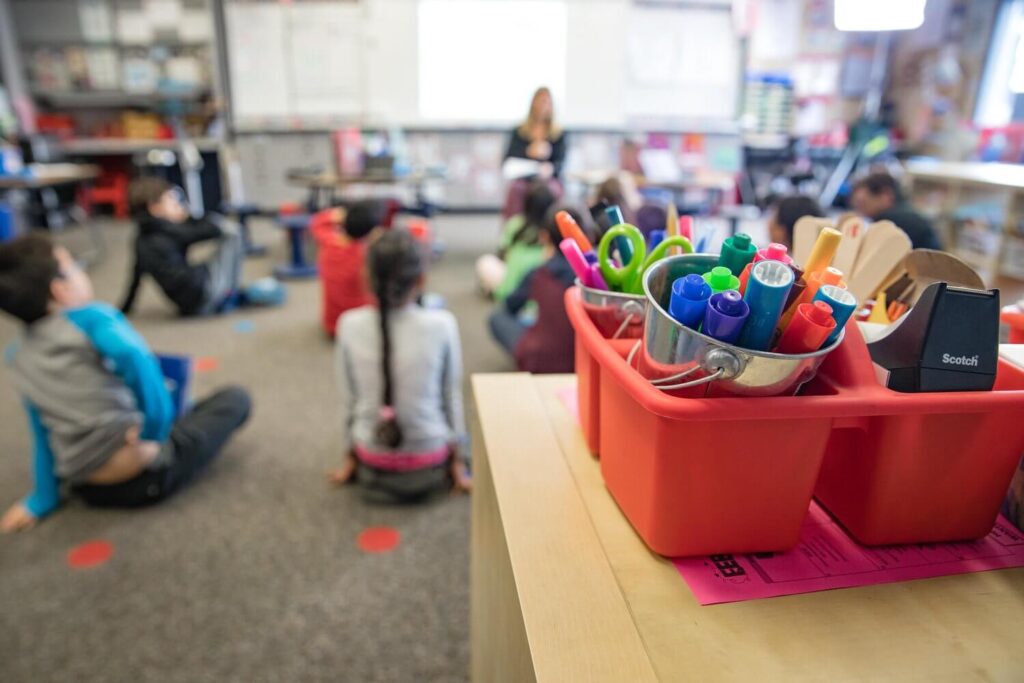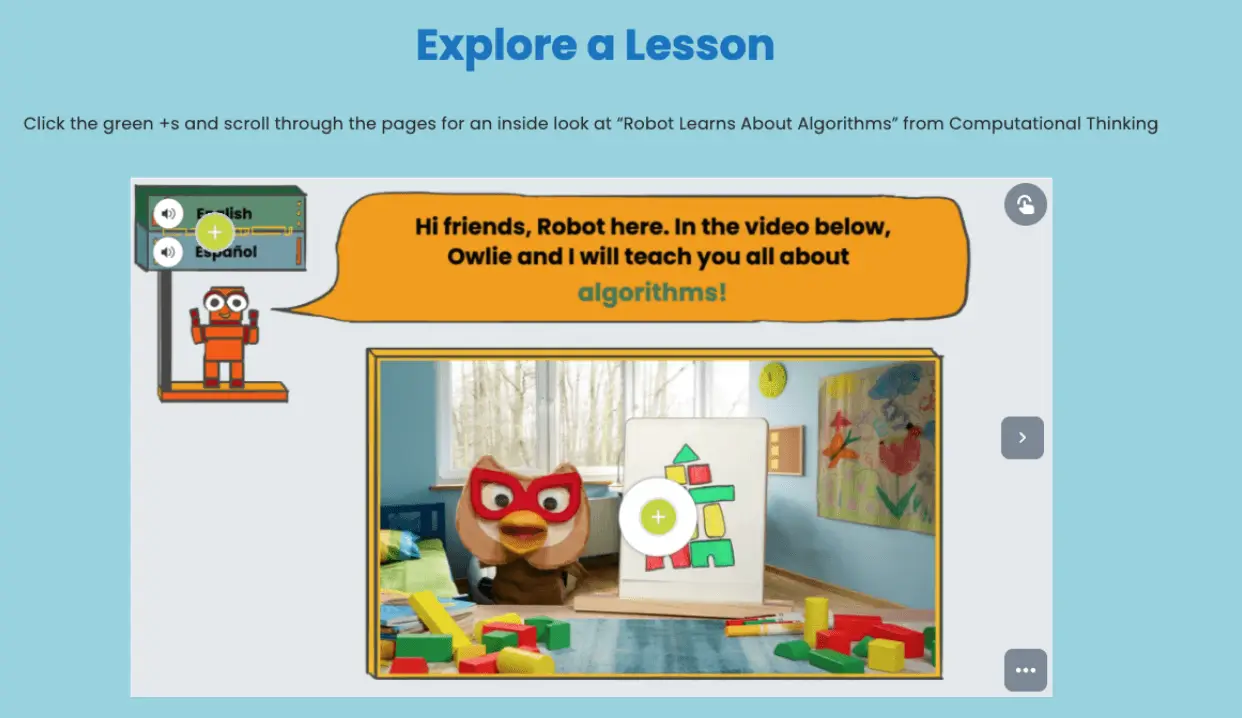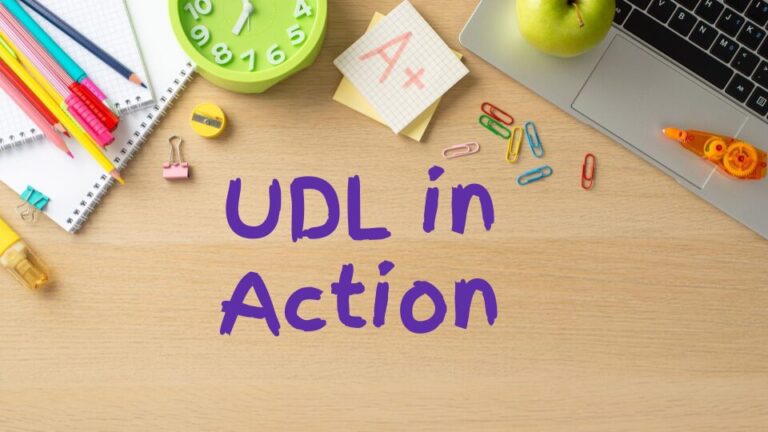With the increased scrutiny on pedagogical best practices due to declining standardized test scores in reading and math, teachers and instructional coaches can feel caught between a rock and a hard place. On one hand, they want to best meet their students’ and families’ needs. On the other hand, access to and understanding of how to integrate research-based practices into their pedagogy can seem impossible. Do not fear! Seesaw is here to help you begin to integrate research-based practices into your practice with ready-to-go resources.
Instructional Strategies for Gradual Release and Active Learning
The gradual release of responsibility1 is an instructional framework where teachers slowly release responsibility of learning to students over time. Teachers begin by describing learning objectives, modeling and thinking aloud to demonstrate key vocabulary and skills, and highlighting the relevance of the lesson. Students observe, make connections, and discuss initial learning with classmates. In this stage, teachers should explicitly teach2 routines to support cognition and comprehension. Seesaw Lessons aid teachers with this crucial explicit instruction. Every lesson begins by introducing important new vocabulary and modeling skills through visuals, audio, video, and more.
@mshoofs_kinders #seesawlearning #seesawpartner @seesawlearning ♬ original sound – Lauren
The gradual release of learning continues through opportunities for students to respond to teacher’s questions and practice new skills with teacher and peer support. Magic happens when students engage in active learning activities with partners and independently. Through investigation, creative activities, discussion, and reflection3, students are able to connect new learning to prior knowledge and transfer learning into longer-term memory.
The Seesaw Library has thousands of activities to help teachers and students engage in investigation and capture creating learning in the real world on a digital platform. Built in prompts spark engaging discussions and questions. Multimodal tools empower students to engage in hands-on learning experiences and select their preferred method for showcasing it.
Seesaw’s elementary Computer Science curriculum empowers both teachers and students to observe, learn, and apply computer science skills to their everyday lives. Teachers can leverage the instructional videos and example coding programs to explicitly model coding skills and vocabulary. Students collaboratively and independently reflect on their interests and create coding projects such as an animated story, game, dance, and more to share with their learning community. Seesaw Lessons help teachers transfer the responsibility of learning to students over time while engaging students in rich active learning experiences.
Some coding with @bishopkinder today using @ScratchJr! ➡️⬅️⬆️⬇️ Introduced coding using Code Crew lesson from @Seesaw Library. Then we used ? to create ourselves as a character and coded ourselves to move across the background. Great job, coders! ?? pic.twitter.com/jkAqSOB9oF
— Traci Piltz ?✨ (@TraciPiltz) September 18, 2023
Multimodal and Interdisciplinary Instruction
Multimodal instruction is the practice of using multiple formats–such as text, visuals, video, audio, hands-on experiments, and movement–to activate students’ thinking in multiple ways, leading to deeper connections and skill mastery. Students often receive multimodal instruction (inputs), but only text-based opportunities to show their understanding (outputs). This presents teachers with a conundrum: how might they tap into what’s going on in their students’ heads?
Teachers often have a narrow window into students’ understanding. Worksheets and assessments offer written insights. Small group and 1:1 oral assessments provide additional insights, but are often time-consuming to implement routinely.
Alternatively, these eight thinking moves4 can help teachers tap into their students’ heads to get a fuller picture of student understanding while empowering students to build new ideas and connections:
- Observe closely and describe what is there
- Share explanations
- Reason with evidence
- Make connections
- Consider different points of view and perspectives
- Understand deeply and draw conclusions
- Wonder and ask questions
- Investigate
Students often engage in many of these thinking moves, but are not given opportunities to capture or share their learning with others. Seesaw’s portfolio with multimodal tools makes it easy for teachers to leverage these eight thinking moves. Learners can capture their wonderings, observations, evidence, and reasoning using their choice of tools: drawing, text, audio, video, and more.
Learning new knowledge also requires different cognitive pathways. Quick checks for understanding reveal short-term memory cognition, but how might teachers tap into students’ longer-term memory and mastery of learning? The key is interdisciplinary, project- or inquiry-based learning.
With Seesaw Lessons, students engage in a variety of activities to activate these pathways that focus on attention, memory, reasoning, communication, and visualization. When students are able to engage in digital inquiry5 and apply learning across subjects or to the real-world6, they develop a more complex, transferrable understanding. These practices empower them to use rather than simply acquire knowledge.
Incorporating Formative Assessment and Providing Immediate Feedback
Formative assessments provide insights to teachers and students about their learning to inform instruction. Immediate feedback7 empowers students to self-correct and redirect their learning. This type of feedback also boosts students’ self-esteem and identities as students8. Researchers Carol Dweck, David Yeager, and Jo Boaler refer to this boost of self-esteem and identities as a growth mindset9. When students have a growth mindset and reflect on their learning, they realize they can learn almost anything when they persevere and try new things.
Formative assessment helps teachers encourage their students’ growth mindsets. Teachers can better differentiate and support their students with timely, actionable feedback. Their can create small groups or engage students in collaborative activities10 to reinforce skills and their growth mindsets.
?AMAZED by the new formative assessment tools in @Seesaw! It took me less than 3 minutes to make an exit ticket using the ?AI BOT! Instant Ss feedback, self-grading & data by class or broken down by individual Ss! The possibilities are ENDLESS! #cbgroveland #seesawlearning pic.twitter.com/IY822rq9nK
— Lindsay Toub (@miss_toub) September 18, 2023
Seesaw’s Formative Assessment feature provides students with immediate feedback11 on multiple-choice, drag and drop, and poll assessments. These quick checks provide students with immediate feedback and the teacher with insights to scaffold or extend learning. When these formative assessments are paired with more open-ended multimodal tools, teachers can get a more holistic picture of students’ understanding. Additionally, teachers can create their own activities with formative assessment or grab standards-aligned, ready-to-go lessons with this tool in the Seesaw Library.
INSERT LESSON PREVIEW IFRAME OR IMAGE AND DELETE THIS TEXT
Culturally Responsive Teaching
Culturally responsive teaching honors and encourages students to connect their cultures, languages, interests, and life experiences to what they’re learning at school. Student strengths are celebrated and nurtured, leading to an increased sense of belonging12.
Seesaw Lessons help students see themselves in their learning through diverse characters, stories, and experiences13. Activities help them build empathy, see diverse learners like themselves, and make connections to everyday life14. Extra care has been given to diverse representation in our computer science collections, as a historically homogeneous field. Students learn digital leadership, coding, and computational thinking skills alongside diverse characters. Lessons collections like Careers in Computer Science, Story Pirates: Story Sparks, and What’s My Job highlight real-life individuals working in a variety of professions, helping students better imagine themselves as digital innovators15, with intersectional, complex identities.
Students also draw from funds of knowledge16, a wealth of diverse experiences and skills, in which they can share to enrich the diversity of their classroom. Seesaw’s portfolio with multimodal tools empower learners to showcase their learning in their preferred way. Every lesson in the Seesaw Library is equipped with audio directions in English and Spanish to increase access and support learners. Spanish lessons include fully translated text, audio, video, and visuals to support multilingual learners practicing and sharing their learning. These learners have access to screen, video, and audio recording tools to orally rehearse before sharing.
Fostering Family Engagement
Family engagement research17 shows the impact of engaging families as co-owners of student outcomes. Families are the experts on their child’s interests and cultural experiences. When there are natural ways to bring that expertise to and from the classroom, students are able to connect new information with their experiences and background knowledge, leading to deeper learning. There are high gains in student achievement when parents are informed of what their child is learning and how to support them at home. Consistent outreach to parents (messaging and sending resources to support the child at home) result in high student achievement. Teachers want to engage with their families to support their students, but reaching every family is complex and time-intensive.
Seesaw helps teachers save that time. Once families are connected to their student, they can participate in their child’s learning by viewing their portfolio, commenting on progress, messaging with teachers, and participating in family activities. Teachers can choose to message student work examples to families, or families can already automatically see their child’s work once it is approved and added to their journals. Teachers invest time in the initial setup so that families are automatically kept in the loop every time their child creates something new in Seesaw.
Families can tap into their funds of knowledge and contribute to classroom culture and their child’s learning by commenting on their child’s work and messaging with the teacher. Messages and comments translate into over 100 languages, increasing accessibility. Families can stay up-to-date with classroom events and follow up on student learning at home. Teachers can send reminders or share helpful resources for families to utilize to support their child at home.
Seesaw Lessons also include activities designed to be completed with partners at home or school. These activities explain the importance of this activity or domain to their child’s development. Videos and instructions model for parents how to support and engage in the activities with their child. At Seesaw, families are essential partners to students’ growth. Teachers can easily engage with families with ready-to-go resources, student portfolio work, and messaging tools.
Conclusion
Seesaw is the one learning platform all teachers need to spark engaging, personalized learning for every student and family in meaningful ways. Check out our free Quick Start Guides for teachers and Messages guides for teachers and families to bring multimodal tools, culturally responsive lessons, active learning opportunities; formative assessments; and family engagement practices into your classroom today. Rest assured that you are integrating research-based best practices into your pedagogy by integrating Seesaw into your daily instruction.
References
- Fisher, Douglas, and Nancy Frey. Better Learning through Structured Teaching: A Framework for the Gradual Release of Responsibility. ASCD, 2008. https://files.ascd.org/staticfiles/ascd/pdf/siteASCD/publications/books/Better-Learning-Through-Structured-Teaching-3ed-sample-chapters.pdf
- Pearson, P. D., & Gallagher, M. C. (1983). The instruction of reading comprehension. Contemporary Educational Psychology, 8(3), 317–344. https://doi.org/10.1016/0361-476X(83)90019-X
- Resnick, Mitchel, and Ken Robinson. Lifelong Kindergarten : Cultivating Creativity through Projects, Passion, Peers, and Play. Cambridge, Massachusetts, The Mit Press, 2018. https://mitpress.mit.edu/9780262536134/lifelong-kindergarten/
- Ritchhart, Ron, et al. Making Thinking Visible: How to Promote Engagement, Understanding, and Independence for All Learners. San Francisco, Ca, Jossey-Bass, 2011. https://pz.harvard.edu/sites/default/files/Chapter%201%20MTV%20Ritchhart%20Sample.pdf
- Coiro, Julie, et al. From Curiosity to Deep Learning: Personal Digital Inquiry in Grades K-5. Portsmouth, New Hampshire, Stenhouse Publishers, 2019. https://eric.ed.gov/?id=ED596069
- Repko, Allen F. “Assessing Interdisciplinary Learning Outcomes.” Academic Exchange Quarterly, Fall 2008, p.171-178. https://interdisciplinarystudies.org/docs/syllabi/Assessing_Interdisiplinary_Learning_Outcomes_(Allen_F._Repko).pdf
- Fyfe, E. R., & Rittle-Johnson, B. (2016). The benefits of computer-generated feedback for mathematics problem solving. Journal of Experimental Child Psychology, 147, 140–151. https://doi.org/10.1016/j.jecp.2016.03.009
- Black, Paul, and Dylan Wiliam. “Inside the Black Box: Raising Standards through Classroom Assessment.” Phi Delta Kappan, vol. 92, no. 1, Sept. 2010, pp. 81–90, https://doi.org/10.1177/003172171009200119.
- Dweck, Carol S., and David S. Yeager. “Mindsets: A View from Two Eras.” Perspectives on Psychological Science, vol. 14, no. 3, Feb. 2019, p. 174569161880416, www.ncbi.nlm.nih.gov/pmc/articles/PMC6594552/, https://doi.org/10.1177/1745691618804166.
- Boaler, J. (2000) (Ed) Multiple Perspectives on Mathematics Teaching and Learning. Ablex Publishing: Westport, CT. (pp 171-200). https://www.youcubed.org/wp-content/uploads/2022/04/Chapter-7-of-Multiple-Perspectives-on-Mathematics-Teaching-and-Learning.pdf
- Butler, A. C., & Roediger, H. L. (2008). Feedback enhances the positive effects and reduces the negative effects of multiple-choice testing. Memory & Cognition, 36(3), 604–616. https://doi.org/10.3758/mc.36.3.604
- Cohn-Vargas, Becki, et al. Belonging and Inclusion in Identity Safe Schools. Corwin Press, 17 Aug. 2021. https://eric.ed.gov/?id=ED614224
- Morris, T. T., Dorling, D., Davies, N. M., & Davey Smith, G. (2021). Associations between school enjoyment at age 6 and later educational achievement: Evidence from a UK cohort study. Npj Science of Learning, 6(1). https://doi.org/10.1038/s41539-021-00092-w
- Ryoo, Jean J. “Pedagogy That Supports Computer Science for All.” ACM Transactions on Computing Education, vol. 19, no. 4, 16 July 2019, pp. 1–23, https://dl.acm.org/doi/10.1145/3322210.
- Kimberly A. Scott, Kimberly M. Sheridan & Kevin Clark (2015) Culturally responsive computing: a theory revisited, Learning, Media and Technology, 40:4, 412-436, DOI: 10.1080/17439884.2014.924966. https://www.tandfonline.com/doi/abs/10.1080/17439884.2014.924966?journalCode=cjem20
- González, N., Moll, L. C., & Amanti, C. (Eds.). (2005). Funds of knowledge: Theorizing practices in households, communities, and classrooms. Lawrence Erlbaum Associates Publishers. https://psycnet.apa.org/record/2005-06807-000
- Henderson, Anne T, et al. A New Wave of Evidence: The Impact of School, Family, and Community Connections on Student Achievement. Austin, Tex., National Center For Family & Community Connections With Schools, 2002. https://sedl.org/connections/resources/evidence.pdf




